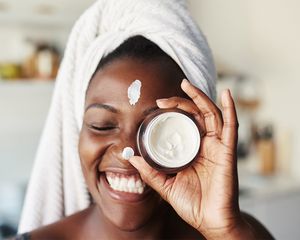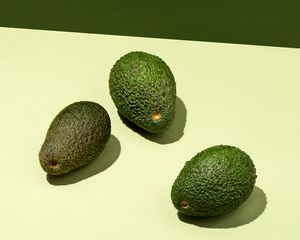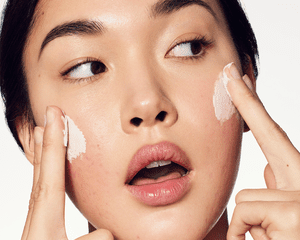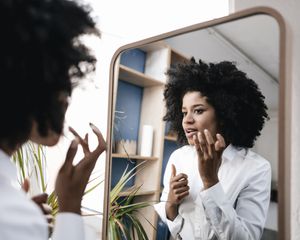:max_bytes(150000):strip_icc()/menopausal-acne-a4ef5c9b7d314d6badfca1538371c18f.png)
Stocksy
Menopause signals the end of one chapter of life and the beginning of another. While the process can be transforming and empowering for many, it can also be less than glamorous at times. Hot flashes, mood swings, and constant breakouts are just some of the many symptoms that go along with it. Acne does not discriminate against age—the hormonal changes during menopause can result in acne before, during, and after, too.
The good news? With the right approach and treatment plan, there are ways to help keep menopausal acne in check without derailing your other skincare goals. Ahead, board-certified dermatologists Ife J. Rodney, MD, and Jessie Cheung, MD, explain everything you need to know about what sets menopausal acne apart from other types of breakouts.
Keep reading to learn more about menopausal acne and what you can do to clear your skin.
Meet the Expert
- Ife J. Rodney, MD is a board-certified dermatologist and founder of Eternal Dermatology in Fulton, Maryland.
- Jessie Cheung, MD is a board-certified dermatologist in Willowbrook, Illinois.
What Is Menopausal Acne?
Menopausal acne is a type of hormonal acne that occurs during, you heard it, menopause. "Hormonal changes are one of the biggest reasons for acne, and there's no bigger time of hormonal change in life than menopause," says Rodney.
The condition is somewhat of a misnomer, given that menopause occurs in stages, and menopausal acne occurs not just during menopause but also during perimenopause, too. "Perimenopause is the transition period that leads up to menopause, usually happening two to eight years earlier," explains Rodney. "Since the average age of menopause is 51, it’s not uncommon for [people] in their early 40s to experience menopausal acne." Cheung agrees, noting that initial hormonal changes may not be enough to stop your period fully, but they are enough to make your skin (and emotions, for that matter) go haywire, It can then extend even into postmenopause, sometimes well into a person assigned female at birth's 50s, adds Rodney.
What Does Menopausal Acne Look Like?
Like other types of hormonal acne, the defining characteristic is deep, tender bumps or cysts, mainly around the mouth, chin, and jawline, as well as whiteheads. This is in contrast to non-hormonal acne, which can look like blackheads and sebum-filled bumps on oily areas of the face, like the T-zone. Another tell-tale sign that you're dealing with menopausal acne? Its location. "It often manifests along with excess facial hair, especially on the chin and upper lip," says Cheung.
Causes and Prevention
Ultimately, the main cause of menopausal acne is hormonal changes, but let's unpack that a bit further:
- Decreased estrogen: Levels of estrogen, the sex hormone responsible for maintaining the female reproductive system and secondary sex characteristics, plummet rapidly during menopause, throwing off the delicate balance of androgens, most specifically testosterone. "As estrogen levels fall, the relative increase of testosterone results in oily skin and clogged pores," explains Cheung. That spike of testosterone also causes increased facial hair growth and is why this type of acne shows up on the lower face, as it seems that this is where more androgen receptors live, she adds. Estrogen and testosterone are the same key hormones at play when acne pops up at other times, for example, during puberty and early adulthood. But during those periods, it's more of a function of either an increase of both or the two fluctuating and not remaining stable rather than this drastic drop in estrogen. It's also worth noting that decreased estrogen impacts the skin in other ways as well (but more on that to come). Attempting to level off these hormonal imbalances—as much as possible—is ultimately the best way to both prevent and treat menopausal acne.
- Stress: As any person who has experienced or is experiencing menopause will quickly tell you, it's a stressful time. Unfortunately, this becomes a double-edged sword: "Stress due to the many other changes happening within the body also contributes to acne," Rodney says. Along with impacting hormone levels in general, stress increases cortisol in the body, the aptly dubbed stress hormone. "It wreaks havoc on the skin in many ways, triggering breakouts through increased oil production being just one of them," she says. While it's obviously easier said than done, attempting to reduce stress as much as possible during, before, and after menopause is paramount.
Menopausal Acne Treatment Options
Unlike the topical approach often favored for other types of acne, treating menopausal acne requires an "inside out" approach. "The most effective treatments focus on correcting the hormonal imbalance," says Rodney.
Oral Medications
Both dermatologists say spironolactone, an oral medication first used to treat high blood pressure, is one of the most often used. It gets right to the root of the issue, an anti-androgen medication that blocks the androgen receptors in the skin, helping to prevent both acne and excess facial hair growth, says Cheung. While it's often used to treat adult acne for those in their 20s and 30s, it's even a better option in an older patient population, she adds. Spironolactone may cause birth defects in those who are pregnant—that's obviously not a concern during menopause.
Oral contraceptive pills can also help with regulating hormone levels, but these should only be used when prescribed by your gynecologist, as there are potential side effects in menopausal people, cautions Rodney. Similarly, it's worth pointing out that while hormone replacement therapy, or HRT, is often used to treat other issues associated with menopause (such as osteoporosis, hot flashes, and vaginal dryness), it may actually exacerbate hormonal acne due to the synthetic hormone progestin, she says.
Topicals
From a topical standpoint, many of the same tried-and-true acne-fighting ingredients, such as benzoyl peroxide and retinoids, can play an important role in combatting menopausal acne—but with one important caveat. That major drop in estrogen also affects the dermal matrix of the skin, in short, leaving you with drier, more reactive skin, explains Cheung. What does that mean when it comes to creating an effective anti-acne routine? She says to be wary of another common acne-fighter, salicylic acid, as it can make dry skin even drier. As far as the other topical ingredients go, seek out gentle formulas—ideally ones that use time-released versions of the actives, to help minimize the likelihood of increased dryness and irritation.
The Final Takeaway
Menopausal acne is a type of hormonal acne that occurs when people assigned female at birth go through menopause. This type of acne can manifest as deep cystic acne or inflamed whiteheads. Luckily, "The changes that happen with drops in estrogen around the time of menopause are inevitable, but hormonal acne doesn't have to be," according to Rodney. Oral medications (like birth control and spironolactone), topical treatments, in addition to preventing stress, can reduce the effects of hormonal acne. If you think you are experiencing signs of menopausal acne, speak with a trusted board-certified dermatologist who can better advise you of your treatment options based on your medical history.





